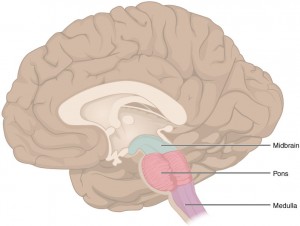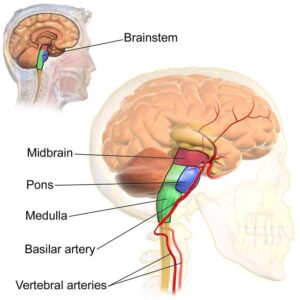 Earlier in the week, writing about the cervical spine, I mentioned that the lowest part of the brainstem extends down through the top of the spinal column to the second cervical vertebrae.
Earlier in the week, writing about the cervical spine, I mentioned that the lowest part of the brainstem extends down through the top of the spinal column to the second cervical vertebrae.
The brainstem is an incredibly important piece of our anatomy acting as the bridge between the brain and spinal cord.
The brainstem—similar in size and shape to the reptilian brain— runs the show that is the human nervous system.
The brainstem coordinates all of the signals sent back and forth from the brain to the body and controls the basic functions of the peripheral nervous system like breathing and blood pressure.
Because all of the cranial nerves pass through it, the brain stem also coordinates movements of the eye, jaw, tongue, and throat, as well as the movements of the neck and head as well as facial expressions.
The brain stem is comprised of three sections—the midbrain, pons, and medulla oblongata. They share some responsibilities and have others specific to themselves.

The midbrain- is the smallest area of the brain and it is involved with voluntary motor function, sight, sound, and body movement.
It acts to relay the information of seeing and hearing through the assorted systems of the body. It controls the nerves that regulate much about our eyes—their size, shape, and movement.
The pons- due to links to the cerebellum, is involved in movement and posture as well as motor control and sensory analysis.
The pons are intimately involved with the breath, regulating the change from inhalation to exhalation, and also deal with sleep and might play a role in generating dreams.
The Medulla Oblongata– is responsible for maintaining much of the autonomic nervous system which includes the all-important sympathetic and parasympathetic nervous systems which maintain the functions mentioned above, such as breathing and blood pressure.
For good measure, we can add responsibility for the reflexes of vomiting, sneezing, coughing, and swallowing.
The importance of the brainstem in our basic functioning and its relationship to the forward head posture that many of us suffer from will be the subject of a future post or two.
The alignment of our head is all important and it is not easy to align the head if we have poor posture.
***
